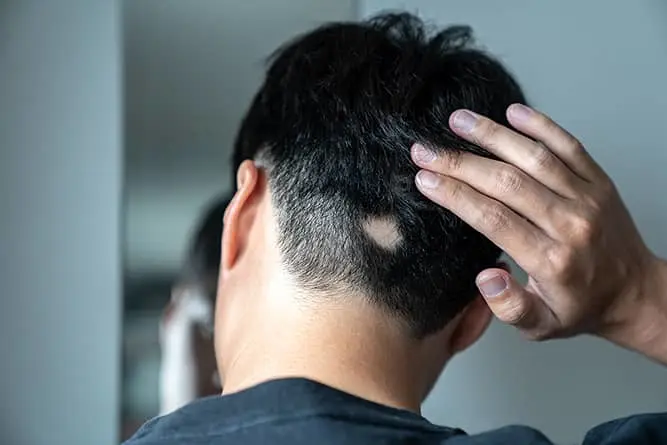Alopecia is defined as temporary or permanent loss of hair, affecting your scalp or your entire body and usually occurs as spot baldness. Alopecia can be caused by medical conditions, heredity, hormonal changes, or it can be a normal part of aging. Anyone can lose their hair, but men are more likely to lose hair.74
Alopecia areata is one of the kinds of alopecia. Alopecia is the medical term for hair loss that is characterized by spot baldness.75
Alopecia areata is considered as an autoimmune disease.76 Essentially, the body attacks its own hair follicles (from which hair grows), resulting in hair loss anywhere on the body77, which appear in the form of spot baldness. Alopecia areata affects many people who are otherwise healthy despite the hair loss and occasionally nail changes. Men and women are equally affected, and while it can occur at any age, children78 and young adults are the most commonly affected, with 30 to 48 percent of patients affected before the age of 20.79
The extent of hair loss or spot baldness varies; in some cases, it is limited to a few areas. Hair loss can be more severe in some people; on rare occasions, the person loses all of his or her hair on the head (alopecia areata totalis) or the entire body (alopecia areata universalis). It is thought that a person's genetic makeup as well as a virus or a substance with which the person comes into contact may trigger the autoimmune reaction of alopecia areata. 80
It is worth mentioning that alopecia areata is a fickle disease. Hair grows back in some people but falls out again later. Hair grows back and remains in others. Each case is distinct. Even if a person loses all of his or her hair, there is a chance that it grows back.81
How is alopecia areata diagnosed: 82
Your dermatologist will carefully examine the area(s) of hair loss as well as your nails. Your dermatologist will also question you. This may be sufficient to diagnose you. However, because there are so many causes of hair loss in men and women, testing may be required to ensure that alopecia areata is the cause of your hair loss.
Treatments to alopecia areata: 83
When treatment is required, your dermatologist will consider your age, the extent of the loss of hair, as well as the location of the hair loss. It's critical to understand that no single treatment works for everyone. To find one that works for you, you may need to try a few different types of treatment or medications.
Treatments to alopecia areata may include the following: 83
Corticosteroid: Corticosteroids, prescribed by a doctor, can aid in hair regrowth. This medication is applied once or twice a day on the bald spots.
Corticosteroid Injections: Corticosteroids are injected with a small needle into bare regions of skin. These injections are normally given by a dermatologist and are repeated every four to six weeks.
Minoxidil: Minoxidil can help maintain regrowth after you stop using the corticosteroid. It has few side effects, making it a good choice for children. In fact, Regaine® contains minoxidil.
Anthralin: You apply this medication to the bald spots, let it sit for as long as your dermatologist recommends, and then wash it off.
Topical Immunotherapy: Diphencyprone (DPCP), dinitrochlorobenzene (DNCB), or squaric acid dibutyl ester (SADBE) are some of the compounds used in this treatment. Topical immunotherapy causes an allergic reaction that alerts the immune system.
People with alopecia can also try a variety of cosmetic and protective techniques. These are some examples to cover the spot baldness: Makeup to conceal or minimize hair loss, sunglasses to shield your eyes from the sun, especially if there is a loss of lashes, head coverings, a balanced diet, and reduction in stress. 84
In conclusion, alopecia areata may be distressing, especially due its unpredictable impact on hair loss. It is essential that you continue following up with your dermatologist and that you seek any support you might need
References:
74https://www.mayoclinic.org/diseases-conditions/hair-loss/symptoms-causes/syc-20372926
75 https://my.clevelandclinic.org/health/diseases/12423-alopecia-areata
76 Han, G. (2017). The changing landscape of alopecia areata: an introduction. Advances in therapy, 34(7), 1584-1585.
77 https://www.aad.org/public/diseases/hair-loss/types/alopecia
78 Nanda, A., Al‐Fouzan, A. S., & Al‐Hasawi, F. (2002). Alopecia areata in children: a clinical profile. Pediatric dermatology, 19(6), 482-485.
80 Lu, W., Shapiro, J., Yu, M., Barekatain, A., Lo, B., Finner, A., & McElwee, K. (2006). Alopecia areata: pathogenesis and potential for therapy. Expert reviews in molecular medicine, 8(14), 1-19.
81 https://my.clevelandclinic.org/health/diseases/12423-alopecia-areata
83 https://www.aad.org/public/diseases/hair-loss/types/alopecia/treatment
84 https://my.clevelandclinic.org/health/diseases/12423-alopecia-areata

